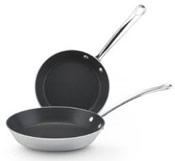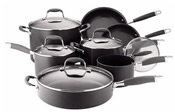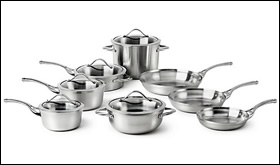Can certain cookware be considered safe cookware or healthy cookware? I go over what makes cookware safe and healthy. You might be surprised at a couple cookware materials! We’ve all heard the phrase “We are what we eat.” We probably haven’t thought of that in terms of aluminum, stainless steel, cast iron, glass, or polytetrafluoroethylene.
Introducing the Your Cookware Helper Exclusive “Healthy Cookware” Logo
![]()
Your Cookware Helper tries to make your cookware decisions as easy as possible. We were the first to introduce a logo to easily identify dishwasher safe cookware. Now, I am happy to introduce you to the Healthy Cookware logo. Soon, you will be seeing it on all the pages identifying the cookware known to be safe and healthy.
You Are Ultimately Responsible For Your Health
 As I write this article and summarize the facts, I don’t need to remind you that ultimately it is you who has to take control and responsibility for your health. As you review this information, you have to decide if what you are presented with makes sense for you. Understand that cookware manufacturers are always going to claim their products are safe. There are industry associations, representing manufacturers, who may conduct some tests and claim certain product lines as safe cookware. Regardless of these claims, it is still you who has to decide whether you believe the tests and arguments presented. History is prolific with examples of products claimed to be safe, tested as being safe, but ultimately recalled or slowly banned from use. Doctors once advertised and promoted cigarette smoking as good and safe. That is one example the medical community would love to forget. So as you read what is presented, it is OK to be skeptical of certain claims and tests. It is your health, and you know you are responsible for your own health.
As I write this article and summarize the facts, I don’t need to remind you that ultimately it is you who has to take control and responsibility for your health. As you review this information, you have to decide if what you are presented with makes sense for you. Understand that cookware manufacturers are always going to claim their products are safe. There are industry associations, representing manufacturers, who may conduct some tests and claim certain product lines as safe cookware. Regardless of these claims, it is still you who has to decide whether you believe the tests and arguments presented. History is prolific with examples of products claimed to be safe, tested as being safe, but ultimately recalled or slowly banned from use. Doctors once advertised and promoted cigarette smoking as good and safe. That is one example the medical community would love to forget. So as you read what is presented, it is OK to be skeptical of certain claims and tests. It is your health, and you know you are responsible for your own health.
What Makes Healthy Cookware or Safe Cookware?
 The most important health factor to consider is the transfer, or leaching, of the cookware cooking surface to the foods being cooked. External surfaces that do not come in contact with food are not a health concern. Copper cookware was once used as a common material to cook food. It was later discovered that native copper interacts with foods, especially acidic foods, and is highly toxic. Today copper is only used clad in between other cookware materials or on the outside, and not on internal cooking surfaces. Another factor is not just the internal cooking surface, but what happens to that cooking surface when it is heated. Heat changes the composition of materials. What may be safe at room temperature can be extremely toxic when applied to a heat source.
The most important health factor to consider is the transfer, or leaching, of the cookware cooking surface to the foods being cooked. External surfaces that do not come in contact with food are not a health concern. Copper cookware was once used as a common material to cook food. It was later discovered that native copper interacts with foods, especially acidic foods, and is highly toxic. Today copper is only used clad in between other cookware materials or on the outside, and not on internal cooking surfaces. Another factor is not just the internal cooking surface, but what happens to that cooking surface when it is heated. Heat changes the composition of materials. What may be safe at room temperature can be extremely toxic when applied to a heat source.
Is Nonstick Cookware Healthy and Safe Cookware?
That is the million dollar question, and most probably, millions of dollars have been spent arguing each side. Additional information can be found on our Nonstick Cookware page. Here’s a synopsis of what we know:
- Teflon is a patented product, discovered in 1938 by DuPont, and approved for cookware by the FDA in 1960.
- Many lawsuits have been filed over the nonstick surface both as a cookware and in its manufacturing.
- “In 2004, DuPont agreed to pay more than $100 million to settle another class-action lawsuit brought by Ohio and West Virginia residents who contended that releases of PFOA from a plant in West Virginia contaminated supplies of drinking water.”
New York Times, Alina Tugend, October 14, 2006 - DuPont acknowledges that when their non stick surface is heated beyond a certain level, it can kill birds and create a sickness in humans they call Polymer Fume Fever. It produces symptoms resembling a cold.
- All nonstick surface manufacturers claim their products are safe. The FDA does not OK a product as “safe” but rather that it is safe for use in cookware.
- There have been no published studies on the effect of ingesting chipping and peeling non stick surfaces have on humans.
I do not consider traditional DuPont nonstick style surfaces to be considered healthy cookware or safe cookware. There are safe and healthy nonstick cookware alternatives, however. DuPont style nonstick cookware has chemicals used in production and use, like PFOA and PTFE, that are known cancer causing agents.
Safe Nonstick Cookware
I do recommend Scanpan as a safe and healthy nonstick cookware. I have been using Scanpan classic cookware for several years now and I love it. It is durable and the nonstick surface is nearly as good now as it was when I bought it. And the best part is that it is truly dishwasher safe. Check this out:
Is Hard Anodized Cookware Safe Cookware?
 Since the 1970’s when Canadian researchers reported that the brains of Alzheimer’s disease victims contained abnormally high levels of aluminum, aluminum cookware has been under fire. “Now cookware manufacturers have developed a process for treating aluminum that retains the heat conductivity properties of the metal, but changes aluminum in other ways. The process, called anodization, involves a series of electrochemical baths that thicken the oxide film that forms naturally on aluminum. This supplemental coating hardens the metal, making it more scratch resistant. Food barely sticks on the hard, smooth surface of this altered aluminum, making it easier to clean.” FDA Consumer Magazine.
Since the 1970’s when Canadian researchers reported that the brains of Alzheimer’s disease victims contained abnormally high levels of aluminum, aluminum cookware has been under fire. “Now cookware manufacturers have developed a process for treating aluminum that retains the heat conductivity properties of the metal, but changes aluminum in other ways. The process, called anodization, involves a series of electrochemical baths that thicken the oxide film that forms naturally on aluminum. This supplemental coating hardens the metal, making it more scratch resistant. Food barely sticks on the hard, smooth surface of this altered aluminum, making it easier to clean.” FDA Consumer Magazine.
In reference to anodized aluminum cookware, I am not referring to the variety that has a nonstick surface applied to the inside. When it comes to health matters, the reality is that there are no published studies indicating safety one way or another. Here are some other things to consider:
- Manufacturers and industry lobbyists all claim it is safe. There is a strong argument in their favor in that the aluminum has been treated, albeit electrochemically, and what the food is cooking on is technically no longer standard aluminum.
- Aluminum is ingested from so many food sources today, the amount leached from cookware, about 35 micrograms, is a fraction ingested from a single antacid tablet, as much as 5,000 micrograms.
Hard Anodized Aluminum Cookware that is in perfect condition appears to be safe cookware. My caution comes under 2 circumstances: 1) Avoid anodized aluminum cookware once it has become scratched and the native aluminum can leach through, and 2) Avoid it if your health routine already has you avoiding aluminum from your diet. Additional information can be found on our Anodized Aluminum Cookware page, or the article Is Anodized Aluminum Cookware Safe.
UPDATE: Since I originally wrote this article, most anodized aluminum cookware comes with a nonstick surface at least on the inside. There are very few product lines available today where food is cooked on the anodized aluminum surface. When it comes to the health aspect, you have to consider the nonstick surface.
Is Stainless Steel Cookware Healthy Cookware?
 Stainless Steel is considered a safe and healthy cookware, with one caveat. It is usually recommended that the inside cooking surface of stainless steel cookware be 18/10 stainless steel. That 18/10 means 18% chromium and 10% nickel. The published safe intake rate of chromium is 50-200 micrograms per day. One meal prepared in 18/10 stainless steel cookware gives you about 45 micrograms. So, that is fine. When it comes to nickel, some people are allergic to nickel. It is thought that the average adult consumes between 150 to 250 micrograms of nickel per day. Even when cooking highly acidic foods like tomatoes or rhubarb, it does not give off anywhere near that amount. If someone is highly allergic to nickel, an alternative is to use a stainless steel cookware with less nickel, like 18/8 or 18/0. Additional information can be found on our Stainless Steel Cookware page.
Stainless Steel is considered a safe and healthy cookware, with one caveat. It is usually recommended that the inside cooking surface of stainless steel cookware be 18/10 stainless steel. That 18/10 means 18% chromium and 10% nickel. The published safe intake rate of chromium is 50-200 micrograms per day. One meal prepared in 18/10 stainless steel cookware gives you about 45 micrograms. So, that is fine. When it comes to nickel, some people are allergic to nickel. It is thought that the average adult consumes between 150 to 250 micrograms of nickel per day. Even when cooking highly acidic foods like tomatoes or rhubarb, it does not give off anywhere near that amount. If someone is highly allergic to nickel, an alternative is to use a stainless steel cookware with less nickel, like 18/8 or 18/0. Additional information can be found on our Stainless Steel Cookware page.
What Cookware Materials Are Considered Healthy and Safe?
Most cooks desiring to cook with healthy cookware will usually use glass/ceramic/stoneware, cast iron, and stainless steel. There is a reason why glass is used in lab experiments. It is not porous and does not react with its contents. Glass cookware has been around for a long time and still used heavily today. Ceramic cookware, though can chip, can have excellent heating properties and be easy to clean. Stoneware can be shaped and colored to be suitable for many decors. Though used primarily inside the stove, there are some pieces that can be used on the stovetop. Additional information can be found on our Glass Cookware page.
Cast iron, plain or enameled, is an excellent choice because of its long lasting heating abilities. The enamel surface is glass based, not paint based. Additional information can be found on our Cast Iron Cookware page.
In this article I summarized the findings on the health aspects of dominant cookware materials. Be sure to check out the links to the individual materials of interest. It is important that everyone take charge of their health, and become knowledgeable about healthy and safe cookware materials.
Happy Cooking!


[…] Because it is still aluminum, questions remain about its safety. In this article, I expand on a previous article on safe and healthy cookware where I first addressed the safety issue of anodized aluminum […]
My grandson has high heavy metal poisoning and is currently going thru detox. He is getting this from somewhere and I believe it’s in the cookware and silverware used in the household. He was currently tested with “off the charts” Cadium, lead, nickel, uranium, iron tungsten, mercury and aluminum. This concerns me greatly and I am trying to find “safe” cookware. I am leaning toward Titanium. What do you think of “hard Anodized Titanium” cookware? and what would be healthy silverware?
Hello Barbara,
I wish your grandson a swift recovery. Hard anodized titanium, particularly the Anolon variety, is aluminum at the core with a teflon-like cooking surface. While the surface is pretty durable, it is a chemical surface and any scratches could reintroduce more aluminum. I would suggest a pan with as much ceramic as possible. The best ceramic compound I’ve found so far is the Cuisinart GreenGourmet, either with a core of stainless steel or anodized aluminum. This is a special surface that does not peel like traditional nonstick surfaces. http://yourcookwarehelper.com/cookware-brands/cuisinart-cookware/cuisinart-greengourmet-cookware/
As for the healthy silverware, I have to pass on that item. That is not my specialty and in reviewing some info about it, it appears to be rather complex as to where the metals are coming from. I don’t feel comfortable giving a recommendation on that.
I hope this helps. Let me know if you have other questions.
Another excellent choice for this situation is Scanpan. I didn’t suggest it below as the price is higher. The Scanpan cooking surface is very durable and does not peel. If the budget allows, please do check out Scanpan. I love mine and it has been tough for a very long time.
Hi we are considering: Circulon Symmetry. Any thoughts on this brand/type of cookwear?